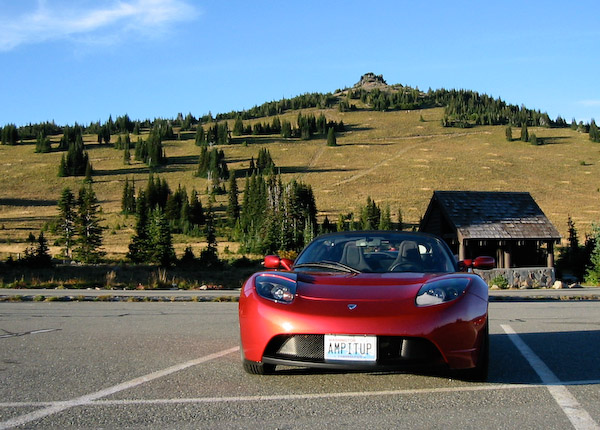During the month, I put about 247.8 kWh into the car from the wall (213.3 kWh metered from my garage plus approximately 34.5 kWh from an unmetered NEMA 14-50 outlet in Longview). That's 325.1 Wh/mi and includes charging losses, battery pack self discharge, heater, headlights, etc. That's my wall-to-wheel number and is based completely on things I can measure.
From July 25th to August 27th, I drove the Roadster 696 miles and pulled 234 kilowatt hours (kWh) from the grid, giving us 336 Wh/mi. That included some hot weather and four 1/4 mile runs at Pacific Raceways.
On individual charges, I see efficiency vary from 240 Wh/mi to over 400 Wh/mi, and obviously much higher for things like drag racing.
I charge consistently at 240V and 40A at home. In Longview it was 230V and 40A. Because of charging overhead, I assume I would get slightly better charging efficiency if I charged at home at 70A. So, my numbers are just that, my numbers. Another driver would get different numbers depending on driving, weather, road conditions, and charging habits.
The EPA estimates documented in the paperwork for our car say 260 Wh/mi city and 290 Wh/mi highway. I've seen information from early 2008 Roadsters that had the EPA numbers and 340 and 360 Wh/mi.
You may have heard Roadster owners talk about numbers well below my 330 Wh/mi numbers. These are most often the number reported by the car's info screen which are not wall-to-wheel numbers, and in fact are (as far as I know) not at all documented as to what that number means. I have figured out some things about the numbers reported by the car, which I'll now explain.
For the month of November, the Roadster's trip meter says that I used 207.9 kWh, and thus 272.8 Wh/mi. But what does that mean? Did I push 207.9 kWh into the motor, or is that net of energy pushed back into the pack from regenerative braking (regen)? Does it include energy used to run the accessories and/or running the coolant pump and fans during charging?
On the "Energy History" screen, the Roadster tells me my "net energy used" for the month was 233 kWh and that I got 26 kWh from regen. What does "net" mean? I would assume that "net" means "net of regen," i.e., power from battery pack minus power into battery pack from regen. Except, if I compare those numbers to what the trip meter says, I notice that 233 - 26 = 207, which is suspiciously close to the energy use number reported on the trip meter.
From that, I infer that the trip meter's number is net energy use from the battery pack (power drawn minus regen put back in), and thus the so-called "net energy" from the energy use screen is really the gross energy pulled from the battery pack including energy that went into the pack from both wall charging and regen charging.
Do these numbers include the energy spent on accessories? Is the difference between what I put in through charging (247.8 kWh) and the car's reported net energy use (207.9 kWh) just charging losses or does that also include accessory use? I have no idea.
The only number I can stand behind, and the only number I can compare with other electric vehicles, is the wall-to-wheel number. The efficiency number reported on various of the Roadster's info screens is useful for understanding how driving style and conditions affect efficiency and for predicting/optimizing range, but is seemingly useless in any other context.
I believe the same is true of any efficiency number for the Leaf given out by Nissan, or any other EV manufacturer or driver, unless that number is as clearly defined and directly measured as the wall-to-wheel number.
It used to be that the Tesla screen reported an energy number after each charge that was much lower that what was actually drawn from the wall. I suspect that was the energy that actually made it into the battery pack, but I never saw it defined by Tesla. More recent firmware versions are reporting a number that is close to the number I read from the wall meter (and averaging multiple consecutive readings together agrees to within 1% of the wall reading). This is a big step forward for drivers who want to monitor their actual wall-to-wheel energy use and efficiency, but don't want to go to the expense of installing a dedicated meter. It would be a real benefit to the Tesla community if Tesla would (a) define the number they currently report and (b) make the energy drawn from the wall across multiple charges easily available.
Regarding range on a single charge, my personal record is 192 miles driven with a passenger in 100+ degree weather starting with a bit less than a full charge and ending with 10 miles of range left. On the trip back from Longview in cool weather, I drove 136.9 miles using cruise control at 55 mph using 55% of the battery. To the extent that you can extrapolate that to the full battery, that figures out to about 249 miles of range. On the trip down to Longview earlier the same day, also using cruise control at 55 mph, it was raining and colder, so I had the wipers, headlights and heater on and used 65% of the battery pack, for an extrapolated range of 208 miles.
My car is a 2008 Tesla Roadster with firmware version "3.4.15 15" (upgraded from "3.4.13 15" on 11/15/2009).
Edited at 10:23 pm on 12/13 to correct typo in second paragraph.

